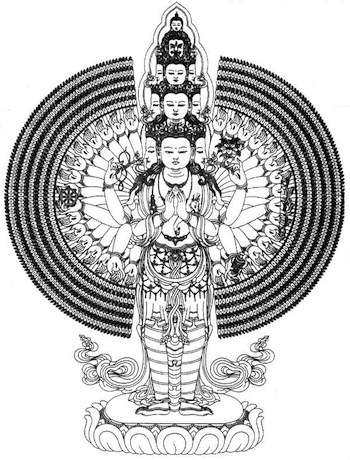According to an old Tibetan tradition, the bodhisattva Avalokiteshvara has a special relation with the people of Tibet. A bodhisattva is a warrior or hero of enlightenment, a being who is on the path to buddhahood. But in a sense, Avalokiteshvara is even more than a buddha. After attaining buddhahood, he voluntarily returned to the way of a bodhisattva in order to lead all beings to buddhahood. Thus Avalokiteshvara is considered the manifestation of the selfless, unconditional compassion of the buddhas.

The form of Avalokiteshvara favored by the Tibetans has a thousand arms, a thousand eyes (in his open palms), and eleven heads. He is said to have acquired these many arms and heads as a result of his frustration with the Tibetans. The story begins when Avalokiteshvara was dwelling in Sukhavati, the Pure Land of Amitabha Buddha, where everything was wonderfully peaceful. Feeling quite confident and expansive, Avalokiteshvara decided to go down to Tibet to help it become a civilized, nonviolent nation. He vowed to Amitabha: “If I should ever get discouraged down there, working with those barbaric Tibetans, may my body be shattered into a thousand pieces.” Then he descended, and for several lifetimes he meditated in the mountains upon boundless compassion, continually emanating waves of love.
In those days the Tibetans were powerful warriors who had conquered much of Central Asia. They also loved to have a good time and eat great quantities of yak meat. In the traditional language of Buddhism, they were difficult to tame. After many lifetimes, Avalokiteshvara began to be aware that such deeply ingrained tendencies are not easily pacified. Just emanating waves of love does not do the trick—violence somehow persists. Offer food to a hungry demon, and he responds by starting to eat your arm. In a moment when Avalokiteshvara was not guarding his mind, he thought: “These evil, violent Tibetans are insatiable. No matter how peaceful and loving I am, it has no effect.” He became a bit discouraged and wept, they say, two tears. From each tear a goddess was born, one white and one green—the two forms of Tara. The two goddesses said, “Stop weeping, we’ll help you. Please calm yourself.” And their words indeed calmed him down for a lifetime or two. At last, however, he became truly discouraged, and in that moment his body was instantly shattered into bits.
Then one of the fragments of the bodhisattva cried out in despair to Amitabha Buddha for help. Amitabha came down to the place where Avalokiteshvara’s pieces were strewn about the mountain. In typical guru fashion, he looked down at the broken bodhisattva and said, “What’s your problem? Who ever told you to take such an ambitious vow? What have you done to yourself? You know, you should always be careful about what you wish for, because—whatever it is, good or bad—sooner or later you will get it.” Then Amitabha blessed the bodhisattva, and the thousand pieces became an imposing figure with a thousand arms, a thousand eyes, and eleven heads.
♦
From Inner Peace, World Peace: Essays on Buddhism and Nonviolence, edited by Kenneth Kraft, reprinted with permission from SUNY Press.
Thank you for subscribing to Tricycle! As a nonprofit, we depend on readers like you to keep Buddhist teachings and practices widely available.